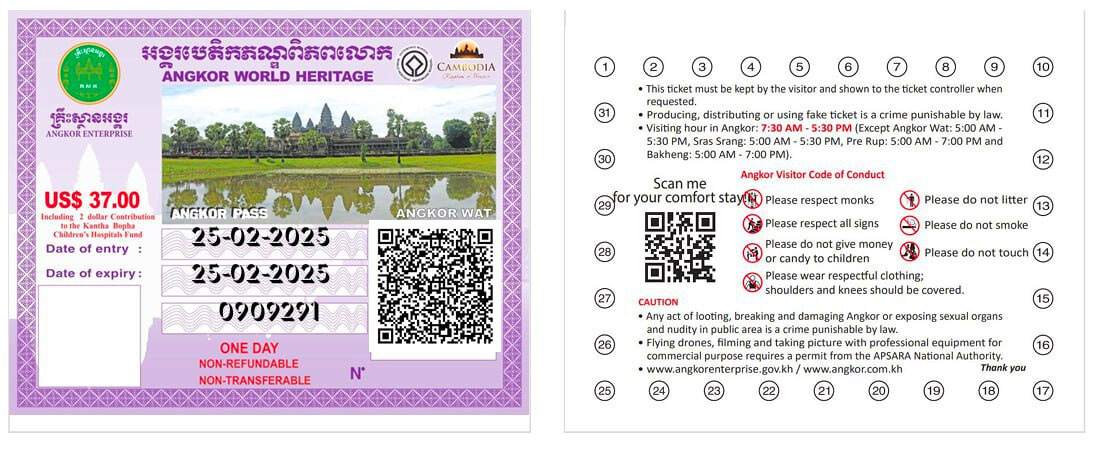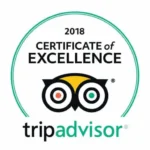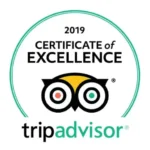This Angkor Pass Lets You See Carved Wonders That Stir Your Soul
Your Angkor Wat entrance ticket opens the door to one of the world’s greatest treasures. This small piece of paper unlocks an amazing world of ancient temples, stunning artwork, and jaw-dropping beauty. You need to know how to get your Angkor Wat entrance ticket right. The wrong choice could mess up your whole trip start.
The Ultimate Guide to Angkor Wat Entrance Ticket – Everything You Must Know
Cambodia welcomes you with open arms and ancient wonders. Siem Reap serves as the gateway to Angkor Wat, a place where stone tells stories over 900 years old. Tourists from around the world come to see these amazing temples. Your Angkor Wat entrance ticket is your key to this world of wonder.
1. Types of Angkor Wat Entrance Tickets and Their Prices
The Angkor Wat entrance ticket comes in three main options. Each ticket type fits different travel plans and budgets. You should pick based on how much time you want to spend exploring.
One-Day Pass ($37)
Perfect for quick trips, this pass gives you a full day at Angkor Wat. You can see the main temples in one rushed day. Many travelers choose this option when short on time. The one-day Angkor Wat entrance ticket works best if you focus on just the main sites.
- Price: $37
- Best for: Quick visits or those on tight schedules
- Tip: Start early! The park opens at 5:00 AM for sunrise
Three-Day Pass ($62)
This middle option gives good value for most visitors. Your pass lets you visit on any three days within a 10-day window. You don’t need to use it on three days in a row. The three-day Angkor Wat entrance ticket gives you time to see both famous and less-known temples.
- Price: $62
- Best for: Most tourists who want to really see Angkor
- Tip: Take a rest day between temple visits to avoid temple fatigue
Seven-Day Pass ($72)
For true temple lovers, this pass provides the most value. You can visit on any seven days within a one-month period. The seven-day Angkor Wat entrance ticket works great for photographers, history buffs, and those who like to take things slow.
- Price: $72
- Best for: In-depth exploration and serious photographers
- Tip: Use this pass to visit at different times of day for the best light
Good to know: Each Angkor Wat entrance ticket includes a $2 donation to the Kantha Bopha Children’s Hospital. Your visit helps local kids get medical care.

2. Where to Buy Your Angkor Wat Entrance Ticket
You must get your ticket from official sources. Fake tickets exist but will cause you big problems if caught. The system has gone digital in recent years, making things easier.
Official Ticket Office
The main place to buy tickets sits about 4 km from downtown Siem Reap. Nearly all tuk-tuk drivers know this spot. The office opens at 5:00 AM and closes at 5:30 PM every day.
- Address: Road to Angkor Wat, corner of Apsara Road
- Hours: 5:00 AM – 5:30 PM daily
- Payment: Cash (USD preferred) or credit cards accepted
Self-Service Ticket Machines
New self-service machines make buying tickets faster. Find these kiosks at:
- The main ticket office
- Heritage Walk Shopping Mall in town
- Near Angkor Wat entrance
The machines take credit cards and work in several languages. They’re a great way to skip the line during busy mornings.
Online Purchase Options
You can now buy your Angkor Wat entrance ticket online through the official website. The process works like this:
- Visit the Angkor Enterprise website
- Create an account
- Select your ticket type
- Upload a photo (for multi-day passes)
- Pay by credit card
- Download your e-ticket with QR code
The official online ticket portal makes things much simpler. You just show the QR code on your phone at the entrance.
Pro Tip: Buy Your Ticket the Evening Before
A smart trick: buy your ticket after 5:00 PM the day before your visit. Tickets bought after 5:00 PM count for the next day, but you can use them that same evening to watch sunset at Angkor Wat for free! This gets you an extra visit at no cost.
3. Understanding the Angkor Park Pass System
The Angkor Wat entrance ticket is more than just a pass to one temple. It gives you access to the whole Angkor Archaeological Park with over 50 temples. Some far-away temples like Banteay Srei and Beng Mealea need the same ticket.
What Your Ticket Includes
Your Angkor Wat entrance ticket covers:
- All major temples in the main Angkor complex
- Angkor Thom and the Bayon
- Ta Prohm (the “Tomb Raider” temple)
- Banteay Srei (about 25 km from the main area)
- Roluos Group temples
- Beng Mealea (with some extra rules)
What’s Not Included
Some places near Angkor need separate tickets:
- Phnom Kulen National Park ($20)
- Koh Ker temple complex ($10)
- Tonle Sap Lake boat tours
Special Rules for Using Multi-Day Passes
Multi-day passes have flexible rules that help you plan better:
- Three-day pass: Use on any 3 days within a 10-day period
- Seven-day pass: Use on any 7 days within a one-month period
- Your pass gets checked and scanned each day you enter
- You can exit and re-enter the park multiple times on the same day
- Lost tickets are not replaced – keep them safe!
4. Best Times to Visit Angkor Wat with Your Ticket
When you visit affects your whole experience. The time of day and season change what you’ll see and how comfortable you’ll be.
Sunrise and Sunset: Magic Hours
The most popular times to visit happen at the day’s edges. Your Angkor Wat entrance ticket gives access to these special moments:
Sunrise at Angkor Wat
- Gates open at 5:00 AM
- Best spot: The pools in front of Angkor Wat
- Arrive by 5:15 AM to get a good spot
- Learn more about sunrise tours
Sunset at Various Temples
- Phnom Bakheng (limited to 300 people at a time)
- Pre Rup temple
- East Mebon
- Sunset tour options
Beating the Crowds: Strategic Timing
Smart visitors use their Angkor Wat entrance ticket to avoid the biggest crowds:
- Early morning (7:00-9:00 AM): After sunrise crowds leave, before tour buses arrive
- Lunch time (12:00-1:30 PM): When tour groups take lunch breaks
- Late afternoon (3:30-5:00 PM): After most day-trippers have left
Seasonal Considerations
Cambodia has two main seasons that affect your visit:
Dry Season (November-April)
- More tourists and higher prices
- Better for photography
- Comfortable mornings and evenings
- Very hot middays (March-April can reach 100°F/38°C)
Rainy Season (May-October)
- Fewer tourists and lower hotel rates
- Lush green surroundings
- Cooler temperatures
- Possible rain delays (usually short afternoon showers)
- More about visiting during different seasons
5. How to Make the Most of Your Angkor Wat Entrance Ticket
Your ticket costs good money, so you should get full value from it. A bit of planning helps you see more without feeling rushed.
Suggested Itineraries by Ticket Type
One-Day Pass Itinerary
- 5:00 AM: Angkor Wat sunrise
- 8:00 AM: Angkor Thom and Bayon
- 11:00 AM: Lunch break
- 1:00 PM: Ta Prohm
- 3:00 PM: Banteay Kdei
- 5:00 PM: Pre Rup for sunset
Three-Day Pass Sample Plan
- Day 1: Main circuit (Angkor Wat, Angkor Thom, Ta Prohm)
- Day 2: Rest or visit Tonle Sap Lake
- Day 3: Grand circuit (Preah Khan, Neak Pean, East Mebon)
- Day 4: Rest day
- Day 5: Banteay Srei and outlying temples
Seven-Day Pass Strategy
- Mix main temples with lesser-known sites
- Schedule rest days between temple days
- Visit the same temples at different times for varied photos
- Take full day trips to distant temples like Beng Mealea
Transportation Options in the Park
Your Angkor Wat entrance ticket doesn’t include transportation inside the park. The site spans over 400 square kilometers. Most people hire:
Tuk-tuk
- Cost: $15-25 per day
- Good for: Small groups, standard routes
- Pros: Affordable, breezy, authentic experience
Private Car with Driver
- Cost: $35-50 per day
- Good for: Comfort, air conditioning, longer distances
- Pros: Escape the heat, store your stuff safely
Bicycle Rental
- Cost: $2-5 per day
- Good for: Fitness enthusiasts, short distances
- Pros: Freedom to explore at your own pace
E-bikes/Scooters
- Cost: $10-15 per day
- Good for: Independence without exhaustion
- Pros: Split the difference between bicycle and tuk-tuk
Tour Guide Options
While not required, a guide makes your Angkor Wat entrance ticket more valuable by explaining what you’re seeing:
Licensed Tour Guide
- Cost: $30-45 per day
- Languages: English, Chinese, Japanese, French, German, Spanish
- Benefits: Rich historical context, local insights, help with photos
- Book through: Hotels, travel agencies, or Journey Cambodia
6. Rules and Etiquette When Using Your Angkor Wat Entrance Ticket
Angkor isn’t just a tourist site—it’s a sacred place for Cambodians. Your behavior should show respect.
Dress Code Requirements
Strict dress codes apply at key temples, especially when climbing to upper levels:
Required at all temples
- Shoulders covered (no tank tops)
- Knees covered (no short shorts or skirts)
- No revealing clothing
For Bakan Sanctuary (upper level of Angkor Wat)
- Even stricter rules
- No children under 12 allowed
- Limited number of visitors at a time
Important Don’ts
Breaking these rules can get you in trouble or even kicked out:
- Don’t touch carvings or sit on ancient structures
- Don’t climb where not permitted
- No drones without special permits
- No smoking inside temple areas
- No loud behavior (temples are places of worship)
- Don’t give money to children selling souvenirs
Photography Tips and Restrictions
Your camera can capture amazing memories, but follow these rules:
- Tripods allowed but may need special permit in some areas
- Flash photography not allowed in some interiors
- Professional photo/video shoots need permits
- Some Buddhist shrines don’t allow photos
- Always ask before photographing monks or nuns
7. New Digital Features of the Angkor Wat Entrance Ticket System
The ticket system has gone high-tech in recent years. These changes make your visit easier.
E-Tickets and QR Codes
The modern Angkor Wat entrance ticket now works digitally:
- Purchase online through the official website
- Get a digital ticket with QR code
- Store it on your phone or print it out
- Scan at entry points instead of physical inspection
- No more waiting in line for photos (for one-day passes)
New self-service kiosks make buying tickets faster. The machines cut ticket purchase time by up to 40%. These changes help you spend less time in line and more time seeing temples.
Mobile App Features
The official Angkor Pass app now offers:
- Ticket purchase and storage
- Maps and GPS navigation
- Basic information about temples
- Updates on special events or closures
- Language options for major tourist languages
Download it before your trip to save time and hassle.
Facial Recognition and Security
For multi-day passes, the system still uses photos for security. One-day passes have moved away from this requirement to speed things up. The park uses digital scanners at entry points to check tickets quickly.
Get Your Angkor Ticket Now – 5 Spots That Save You Hours! The Angkor Park Pass Ticket Counters
8. Tips for Special Visitor Categories
Different types of visitors have special options with the Angkor Wat entrance ticket.
Families with Children
Kids have different needs when visiting Angkor:
- Children under 12 enter free with proof of age (bring passport)
- Plan shorter temple visits with kids
- Visit during cooler morning hours
- Bring plenty of water and snacks
- Consider hiring a guide who’s good with children
- Focus on temples with space to move around
Photographers and Artists
If capturing Angkor’s beauty is your main goal:
- Seven-day pass gives the most photo opportunities
- Ask for special permits for tripods at ticket office
- Plan around the light (early morning for east-facing temples)
- Lesser-known temples often have better photo spots
- Sunset photography ideas
Visitors with Mobility Issues
Angkor presents challenges for those with mobility concerns:
- Most temples have steep, uneven stairs
- Limited accessible paths at main temples
- Consider hiring a car with driver for door-to-temple transport
- Angkor Thom and parts of Angkor Wat have some flat areas
- Visit during dry season when paths are less slippery
9. Common Questions About Angkor Wat Entrance Tickets
Visitors often ask these questions about tickets:
Can I Share My Ticket with Someone Else?
No. Each Angkor Wat entrance ticket is personal and checked against ID or photo. Guards look for ticket sharing and will fine you if caught.
What If I Lose My Ticket?
Bad news: lost tickets are not replaced. You must buy a new one. Keep your ticket in a ziplock bag or pouch. Take a photo of it as backup.
Are There Any Days When Angkor Wat Is Free?
For foreign visitors, no. Cambodian nationals enter free with ID. Some special Khmer holidays might offer limited free access, but this rarely applies to tourists.
Can I Exit and Re-enter the Park?
Yes. Your ticket allows multiple entries on the same day. You can leave for lunch in town or a midday hotel break, then return later.
Do I Need to Bring My Passport?
Not always, but it’s smart to have it. Random checks happen sometimes. Definitely bring it if using a child’s free entry or claiming student discounts.
10. Value-Added Experiences With Your Angkor Wat Entrance Ticket
Make your ticket worth even more with these added experiences.
Exclusive Access Options
Some special programs give extra access:
- Early bird specials (pre-dawn entry)
- Behind-the-scenes conservation tours
- Angkor Wat upper level (Bakan) limited access
- Special sunset viewing platforms
- VIP sunrise tours
Cultural Shows and Events
Your visit can include more than just temples:
- Apsara dance performances in Siem Reap
- Shadow puppet shows
- Traditional music concerts
- Seasonal Buddhist festivals
- Craft demonstrations in nearby villages
Combination Tours and Packages
Many tour operators offer packages that include:
- Angkor Wat entrance ticket
- Transportation
- Guide services
- Meals
- Hotel pickup/drop-off
- Complete tour packages
These can save money and hassle compared to arranging everything separately.
11. Understanding Where Your Ticket Money Goes
Your Angkor Wat entrance ticket does more than just let you in. The money helps preserve this amazing place.
Conservation and Restoration Projects
A large portion of ticket revenue funds:
- Temple restoration work
- Structural repairs
- Art conservation
- Environmental protection
- Research and documentation
Community Benefits
Local communities receive support through:
- Jobs for local guides and staff
- Infrastructure improvements
- $2 per ticket to children’s hospital
- Training programs for heritage workers
- Clean water projects
Future Development Plans
The Angkor authority uses funds for long-term improvements:
- Better visitor facilities
- New tourist routes to reduce crowding
- Digital preservation of carvings
- Climate change adaptation measures
- Protection against flooding
12. Getting to Angkor Wat from Siem Reap
Your journey begins in Siem Reap town, the gateway to Angkor.
Transportation Options
Getting from town to the temples takes about 20-30 minutes:
Tuk-tuk
- Most popular option
- Cost: $5-8 one-way, $15-25 for full day
- Best for: Authentic experience, photos, feeling the breeze
- Book through: Hotel, street, or apps like Grab or PassApp
Private Car/Taxi
- Cost: $15-20 one-way, $35-50 for full day
- Best for: Comfort, air conditioning, rainy days
- Book through: Hotel or travel agencies
Bicycle
- Cost: $2-5 rental per day
- Distance: About 8 km from town center to Angkor Wat
- Best for: Budget travelers, fitness enthusiasts
Tours
- Cost: Varies widely ($25-100+)
- Options: Group or private tours
- Benefits: Everything handled for you
- Tour options with Journey Cambodia
Important Logistics
Before heading to the temples:
- Buy your Angkor Wat entrance ticket first (not available at temple entrances)
- Bring water, sunscreen, hat, and comfortable shoes
- Start early to avoid midday heat
- Arrange your return transportation in advance
- Agree on price and itinerary before starting
Beyond Angkor – Cambodia’s Secret Temple Treasures That Most Tourists Never See
13. Cambodia and Siem Reap: Gateway to Angkor
Understanding Cambodia and Siem Reap makes your temple visit more meaningful.
Brief History of Cambodia
This amazing country has a rich but often painful past:
- Ancient Khmer Empire (9th-15th centuries): Built Angkor and ruled much of Southeast Asia
- French colonial period (1863-1953): Left European influences
- Independence and civil conflict (1950s-1990s): Including the tragic Khmer Rouge period
- Modern recovery (1990s-present): Peace, tourism growth, and development
About Siem Reap
This charming town serves as your base for Angkor exploration:
- Population: About 230,000
- Location: Northwest Cambodia, near Tonle Sap Lake
- Known for: Hospitality, markets, restaurants, and Pub Street
- Atmosphere: Blend of traditional Cambodian and international influences
- Activities: Cooking classes, museum visits, shopping, spa treatments
Local Culture and Customs
Knowing these basics helps you show respect:
- Greeting: The “sampeah” (pressing palms together) shows respect
- Buddhism: The main religion, with many active temples
- Dress: Modest clothing in public, especially at temples
- Money: US dollars widely used alongside Cambodian riel
- Photos: Always ask before photographing people
14. Expert Tips for the Ultimate Angkor Experience
These insider suggestions help you get the most from your Angkor Wat entrance ticket.
Best Photo Opportunities
Get amazing shots at these less crowded spots:
- The reflecting pools at Angkor Wat (early morning)
- Tree roots at Ta Prohm (late afternoon)
- Face towers at Bayon (midday for even light)
- Terraces at Banteay Srei (morning light brings out the pink stone)
- Photography tips from pros
Lesser-Known Temples Worth Visiting
Escape the crowds at these amazing spots:
- Preah Khan: Huge and atmospheric with fewer visitors
- Ta Som: Famous tree-covered doorway
- Banteay Samre: Well-preserved with beautiful carvings
- East Mebon: Elephant statues and great views
- Beng Mealea: The “jungle temple” (requires travel)
Safety and Health Tips
Stay safe and healthy during your visit:
- Drink plenty of water (2-3 liters minimum per day)
- Use strong sunscreen and reapply often
- Take breaks in shaded areas
- Watch your step on uneven temple stairs
- Bring basic first aid supplies
- Use bug spray (especially in rainy season)
Sunrise in Angkor Wat – The Perfect Start to an Unforgettable Adventure
15. The Future of Angkor Tourism and Ticket Systems
The Angkor Wat entrance ticket system keeps changing to meet modern needs.
Upcoming Changes and Improvements
Recent announcements hint at these future changes:
- Fully digital ticketing system
- New visitor centers at major temples
- More flexible ticket options (possibly adding 2-day passes)
- Better crowd management during peak season
- Enhanced security features to prevent ticket fraud
Sustainability Initiatives
The park works to protect Angkor for future generations:
- Limits on climbing certain fragile structures
- Tree planting programs around the park
- Electric shuttle buses (coming soon)
- Plastic reduction efforts
- Water conservation projects
Long-Term Preservation Plans
Officials have created a 100-year plan that includes:
- Rotating temple access to allow restoration
- Using ticket revenue for conservation
- Training local experts in preservation
- Climate change adaptation strategies
- Cultural education programs
Act Now: Secure Your Gateway to Wonder
Your Angkor Wat entrance ticket opens the door to one of humanity’s greatest achievements. This small paper lets you walk among giant faces carved in stone, touch walls that have stood for nearly a thousand years, and watch the sunrise over spires that have amazed visitors for centuries.
Don’t wait until the last minute to plan this part of your trip. The right ticket choice makes all the difference between a rushed visit and a true journey of discovery.
Ready to step into this world of ancient wonder? Contact Journey Cambodia to help plan your perfect Angkor experience. Our local experts can guide you to the right ticket choice and create a custom itinerary that matches your interests.
The temples have waited centuries for your visit. They’ll be patient a bit longer while you plan the perfect trip to meet them.









